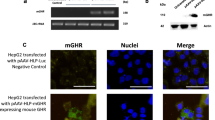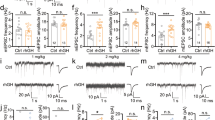Abstract
In earlier work, postnatal growth restriction (more marked in males) was observed in a model of transgenic mice with liver-specific expression of human IGF binding protein-1. This was associated with diminished plasma IGF-I levels, the cause of which remained unexplained. Subsequently, abnormalities of CNS development were ascertained, justifying investigation of the somatotrophic axis. Pituitary gland weight in transgenic animals was reduced proportionally to body weight. Immunohistochemical examination of the pituitaries in 3- to 4-mo-old mice revealed somatotrophs of normal size in homozygotes, but density was decreased to approximately two thirds of that in wild-type siblings (p = 0.001). The same was true of lactotrophs. The GH content of the pituitary was significantly reduced in heterozygotes (p < 0.02) and more so in homozygotes (p < 0.0003), although the GH/total protein ratio was similar to that in wild types. Pituitary perifusion experiments showed that in vitro the amounts of GH secreted under basal conditions and under GH-releasing hormone stimulation were similar in transgenic and wild-type mice. Ten days of treatment with human GH (100 μg/d) in 45-d-old transgenic and wild-type mice provoked significant weight gain (p = 0.02) in all animals, the means being 12.4% for homozygotes and 10.4% in heterozygotes, as opposed to 5.8% in wild-type mice. The increase in weight tended to correlate with an increase in plasma IGF-I. From these results, we conclude that the reduced plasma IGF-I in IGF binding protein-1 transgenic mice may result from insufficient GH production by the depressed number of somatotrophs, possibly associated with functional alteration of hypothalamic control.
Similar content being viewed by others
Log in or create a free account to read this content
Gain free access to this article, as well as selected content from this journal and more on nature.com
or
Abbreviations
- IGFBP:
-
IGF binding protein
- hIGFBP:
-
human IGF binding protein
- GHRH:
-
GH releasing hormone
- ALS:
-
acid-labile subunit
- DAB:
-
3,3′-diaminobenzidine tetrahydrochloride dihydrate
References
Gay E, Seurin D, Babajko S, Doublier S, Cazillis M, Binoux M 1997 Liver-specific expression of human insulin-like growth factor binding protein-1 in transgenic mice: repercussions on reproduction, ante- perinatal mortality postnatal growth. Endocrinology 138: 2937–2947
Lee PDK, Giudice LC, Conover CCA, Powell DR 1997 Insulin-like growth factor binding protein-1: recent findings new directions. Proc Soc Exp Biol Med 216: 319–357
Rajaram S, Baylink DJ, Mohan S 1997 Insulin-like growth factor binding proteins in serum other biological fluids: regulation functions. Endocr Rev 18: 801–831
Lewitt MS, Saunders H, Phuyal JL, Baxter RC 1994 Complex formation by human insulin-like growth factor binding protein-3 human acid-labile subunit in growth hormone-deficient rats. Endocrinology 134: 2404–2409
Giustina A, Veldhuis JD 1998 Pathophysiology of the neuroregulation of growth hormone secretion in experimental animals the human. Endocr Rev 19: 717–797
Rechler MM, Nissley SP 1990 Insulin-like growth factors. In: Sporn MB, Roberts AB (eds) Peptide Growth Factors and Their Receptors. Springer Verlag, Berlin, 263–367
Doublier S, Duyckaerts C, Seurin D, Binoux M 2000 Impaired brain development hydrocephalus in a line of transgenic mice with liver-specific expression of human insulin-like growth factor binding protein-1. Growth Hormone IGF Res 10: 267–274
Lassarre C, Binoux M 2001 Measurement of intact insulin-like growth factor binding protein-3 in human plasma using a ligand immunofunctional assay. J Clin Endocrinol Metab 85: 1260–1266
Doublier S, Seurin D, Fouqueray B, Verpont MC, Callard P, Striker LJ, Striker GE, Binoux M, Baud L 2000 Glomerulosclerosis in mice transgenic for human insulin-like growth factor binding protein-1. Kidney Int 57: 2299–2307
Gatford KL, Egan AR, Clarke IJ, Owens PC 1998 Sexual dimorphism of the somatotrophic axis. J Endocrinol 157: 373–389
Stefaneanu L, Powell-Braxton L, Won W, Chandrashekar V, Bartke A 1999 Somatotroph lactotroph changes in the adenohypophyses of mice with disrupted insulin-like growth factor I gene. Endocrinology 140: 3881–3889
Stefaneanu L, Kovacks K, Horvath E, Asa SL, Losinski NE, Billestrup N, Price J, Vale W 1989 Adenohypophysial changes in mice transgenic for human growth hormone-releasing factor: a histological, immunocytochemical, electron microscopic investigation. Endocrinology 125: 2710–2718
Boujon CE, Bestetti GE, Abramo F, Locatelli V, Rossi GL 1995 The reduction of circulating growth hormone prolactin in streptozotocin-induced diabetic male rats is possibly caused by hypothalamic rather than pituitary changes. J Endocrinol 145: 19–27
Dong Q, Lazarus RM, Wong LS, Vellios M, Handelsman DJ 1991 Pulsatile LH secretion in streptozotocin-induced diabetes in the rat. J Endocrinol 131: 49–55
Dai Z, Xing Y, Boney CM, Clemmons DR, D'Ercole AJ 1994 Human insulin-like growth factor binding protein-1 (IGFBP-1) in transgenic mice: characterization insights into the regulation of IGFBP-1 expression. Endocrinology 135: 1316–1327
Rajkumar K, Barron D, Lewitt MS, Murphy LJ 1995 Growth retardation hyperglycemia in insulin-like growth factor binding protein-1 transgenic mice. Endocrinology 136: 4029–4034
Unterman T, Lacson R, Gotway MB, Oehler D, Gounis A, Simmons RA, Ogata ES 1990 Circulating levels of insulin-like growth factor binding protein-1 (IGFBP-1) hepatic mRNA are increased in the small for gestational age (SGA) fetal rat. Endocrinology 127: 2035–2037
Strauss DS, Ooi GT, Orlowski CC, Rechler MM 1991 Expression of the genes for insulin-like growth factor-I (IGF-) IGF binding proteins-1 -2 in fetal rat under conditions of intrauterine growth retardation caused by maternal fasting. Endocrinology 128: 518–525
Lassarre C, Hardouin S, Daffos F, Forestier F, Frankenne F, Binoux M 1991 Serum insulin-like growth factors insulin-like growth factor binding proteins in the human fetus: relationships with growth in normal subjects in subjects with intrauterine growth retardation. Pediatr Res 29: 219–225
Verhaeghe J, van Bree R, van Erck E, Laureys J, Bouillon R, van Assche FA 1993 C-peptide, insulin-like growth factor I II insulin-like growth factor binding protein-1 in umbilical cord serum: correlations with birth weight. Am J Obstet Gynecol 159: 89–97
Giudice LC, De Zegher F, Gargosky SE, Dsupin BA, de las Fuentes L, Crystal RA, Hintz RL, Rosenfeld RG 1995 Insulin-like growth factors their binding proteins in the term preterm human fetus neonate with normal extremes of intrauterine growth. J Clin Endocrinol Metab 80: 1548–1555
De Waal WK, Hokken-Koelega AC, Stijnen T, De Muinck Keizer-Schrama SM, Drop SL 1994 Endogenous stimulated GH secretion, urinary GH excretion, plasma IGF-I IGF-II levels in prepubertal children with short stature after intrauterine growth retardation. Clin Endocrinol 41: 621–630
Boguszewski M, Rosberg S, Albertsson-Wikland K 1995 Spontaneous 24-hour growth hormone profiles in prepubertal small for gestational age children. J Clin Endocrinol Metab 80: 2599–2606
Chernausek SD, Breen TJ, Frank GR 1996 Linear growth in response to growth hormone in children with short stature associated with intrauterine growth retarda- tion: the national cooperative growth study experience. J Pediatr 122( suppl): S22–S27
De Zegher F, François I, van Helvoirt M, van de Berghe G 1997 Small as fetus short as child: from endogenous to exogenous growth hormone. J Clin Endocrinol Metab 82: 2021–2026
Acknowledgements
The authors thank Pierre Casanovas for technical assistance.
Author information
Authors and Affiliations
Corresponding author
Additional information
Supported by the Institut National de la Santé et de la Recherche Médicale (INSERM) and the Institut National de la Recherche Agronomique (INRA).
Rights and permissions
About this article
Cite this article
Seurin, D., Froment, P., Bluet-Pajot, MT. et al. Functional Alteration of the Somatotrophic Axis in Transgenic Mice with Liver-Specific Expression of Human Insulin-like Growth Factor Binding Protein-1. Pediatr Res 52, 168–174 (2002). https://doi.org/10.1203/00006450-200208000-00007
Received:
Accepted:
Issue date:
DOI: https://doi.org/10.1203/00006450-200208000-00007
This article is cited by
-
Functional consequences of IGFBP excess?lessons from transgenic mice
Pediatric Nephrology (2005)



